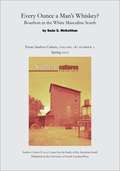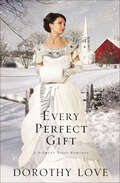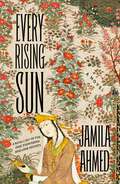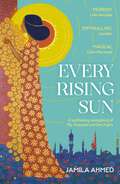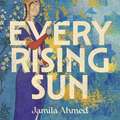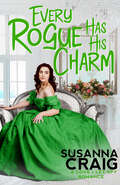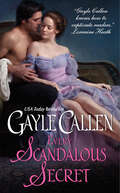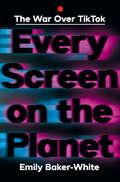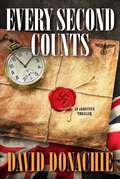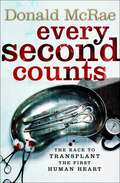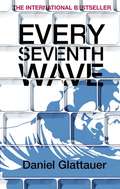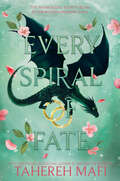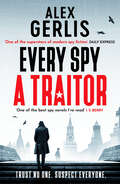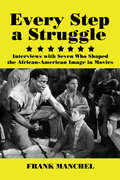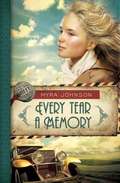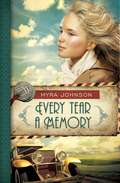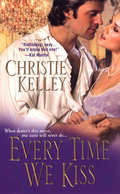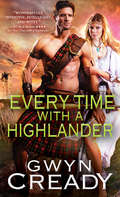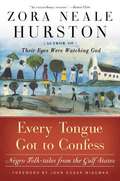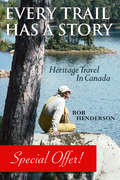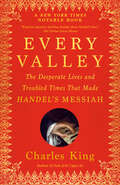- Table View
- List View
Every Ounce a Man’s Whiskey?: Bourbon in the White Masculine South
by Seán S. McKeithanThe hot bite of the Bourbon sensuously connects the body of the drinker to nation, region, and locale, enjoining his experience with those of imagined, historical bodies, soaking up space and place in the slow burn of what appears an endless southern summertime."This article appears in the Spring 2012 issue of Southern Cultures. The full issue is also available as an ebook.Southern Cultures is published quarterly (spring, summer, fall, winter) by the University of North Carolina Press. The journal is sponsored by the University of North Carolina at Chapel Hill's Center for the Study of the American South.
Every Perfect Gift (Hickory Ridge Romances #3)
by Dorothy LoveEthan and Sophie long to share a future together. But the secrets they’re not sharing could tear them apart.Sophie Caldwell has returned to Hickory Ridge, Tennessee, after years away. Despite the heartaches of her childhood, Sophie is determined to make a home, and a name, for herself in the growing town. A gifted writer, she plans to resurrect the local newspaper that so enchanted her as a girl.Ethan Heyward’s idyllic childhood was shattered by a tragedy he has spent years trying to forget. An accomplished businessman and architect, he has built a majestic resort in the mountains above Hickory Ridge, drawing wealthy tourists from all over the country.When Sophie interviews Ethan for the paper, he is impressed with her intelligence and astounded by her beauty. She’s equally intrigued but fears he will reject her if he learns about her shadowed past. Just as she summons the courage to tell him, Ethan’s own past unexpectedly and violently catches up with him, threatening not only his life but their budding romance.“Pure Southern delight! Dorothy Love weaves a stirring romance . . . that uplifts and inspires the heart.” —Tamera Alexander, best-selling author of The Inheritance and A Lasting Impression
Every Promise
by Andrea BajaniWhen Sarah leaves him - heartbroken by their inability to conceive - Pietro reverts to a younger self, leaving the dishes unwashed, his bed unmade and the post unopened. Soon afterwards, Sarah confesses that she is pregnant, but from a casual encounter. She comes to rely on Pietro's mother for support, leaving all three in a painful limbo, unable to move on or return to the way things were. Into the void falls Olmo, an old man haunted by memories of war. At first he provides a distraction, but when he asks Pietro to travel to Russia on his behalf, to right a wrong from his past, he offers this most troubled of young men the chance of a new beginning.
Every Promise
by Andrea BajaniWhen Sarah leaves him - heartbroken by their inability to conceive - Pietro reverts to a younger self, leaving the dishes unwashed, his bed unmade and the post unopened. Soon afterwards, Sarah confesses that she is pregnant, but from a casual encounter. She comes to rely on Pietro's mother for support, leaving all three in a painful limbo, unable to move on or return to the way things were. Into the void falls Olmo, an old man haunted by memories of war. At first he provides a distraction, but when he asks Pietro to travel to Russia on his behalf, to right a wrong from his past, he offers this most troubled of young men the chance of a new beginning.
Every Rising Sun: A Novel
by Jamila AhmedNamed one of NPR's Books We LoveIn this riveting take on One Thousand and One Nights, Shaherazade, at the center of her own story, uses wit and political mastery to navigate opulent palaces brimming with treachery and the perils of the Third Crusade as her Persian homeland teeters on the brink of destruction.In twelfth century, Persia, clever and dreamy Shaherazade stumbles on the Malik’s beloved wife entwined with a lover in a sun-dappled courtyard. When Shaherazade recounts her first tale, the story of this infidelity, to the Malik, she sets the Seljuk Empire on fire. Enraged at his wife’s betrayal, the once-gentle Malik beheads her. But when that killing does not quench his anger, the Malik begins to marry and behead a new bride each night. Furious at the murders, his province seethes on rebellion’s edge. To suppress her guilt, quell threats of a revolt, and perhaps marry the man she has loved since childhood, Shaherazade persuades her beloved father, the Malik’s vizier, to offer her as the next wife. On their wedding night, Shaherazade begins a yarn, but as the sun ascends she cuts the story short, ensuring that she will live to tell another tale, a practice she repeats night after night. But the Malik’s rage runs too deep for Shaherazade to exorcise alone. And so she and her father persuade the Malik to leave Persia to join Saladin’s fight against the Crusaders in Palestine. With plots spun against the Seljuks from all corners, Shaherazade must maneuver through intrigue in the age’s greatest courts to safeguard her people. All the while, she must keep the Malik enticed with her otherworldly tales—because the slightest misstep could cost Shaherazade her head. This suspenseful first-person retelling is vividly rendered through the voice of a fully imagined Shaherazade, a book lover whose late mother bestowed the gift of story that becomes her power. Created over fourteen years of writing and research, Jamila Ahmed’s gorgeously written debut is a celebration of storytelling and a love letter to the medieval Islamic world that brings to life one of the most enduring and intriguing woman characters of all time.
Every Rising Sun: For a thousand and one nights Shaherazade told stories. This is hers.
by Jamila AhmedBefore she was the legendary Persian queen who spun a thousand tales, Shaherazade was a girl who saw something she shouldn't have.She told the king.She thought she was doing what was right.She couldn't have imagined what was to come.The Seljuk Empire is on fire and the king is on a rampage after learning of his wife's infidelity. Unsated by her execution, he has gone on to wed and behead a new wife night after night. Fear spreads through the city and Shaherazade must do something, anything, to halt the horror she has set in motion. When the king starts searching for his next bride, Shaherazade steps forward.As the sun sets on her wedding night, she begins to weave a tale that will go down in history.'A sumptuous, moreish novel infused with the joys of storytelling' LEILA ABOULELA, author of Minaret'I was entranced by this marvel of a book, wound about by the weave of its tales, unable to put it down' CLAIRE GILBERT, author of I, Julian
Every Rising Sun: For a thousand and one nights Shaherazade told stories. This is hers.
by Jamila AhmedFOR A THOUSAND AND ONE NIGHTS SHAHERAZADE TOLD STORIES. THIS IS HERS. A spellbinding reimagining of the Arabian Nights and the fearless woman at the heart of it all: Shaherazade.Before she was the legendary Persian queen who spun a thousand tales, Shaherazade was a girl who saw something she shouldn't have.She told the king.She thought she was doing what was right.She couldn't have imagined what was to come.The Seljuk Empire is on fire and the king is on a rampage after learning of his wife's infidelity. Unsated by her execution, he has gone on to wed and behead a new wife night after night. Fear spreads through the city and Shaherazade must do something, anything, to halt the horror she has set in motion. When the king starts searching for his next bride, Shaherazade steps forward.As the sun sets on her wedding night, she begins to weave a tale that will go down in history.If you had to tell one story to save your life, what would it be?(P) 2023 Macmillan Audio
Every Rogue Has His Charm (Love and Let Spy #4)
by Susanna CraigLove, intrigue, and a fresh spin on historical romance make a sexy and suspenseful mix in the latest novel in Susanna Craig&’s Regency-set series—as the wife one man left behind becomes the woman he can&’t live without . . . Caroline, Marchioness of Chesleigh, has been married for six years—at least in name. In fact, Caro has hardly seen her husband since the early days of their union. Scarred and reclusive, Maxim wasn&’t ready to trust his wife with his secrets—or his heart. Instead, he quickly resumed his life of espionage in France, believing Caro was better off alone. When the spy who left her returns upon inheriting the Dukedom, he finds his wife is not the girl she once was. Her heart is a little harder. She&’s learned to stand on her own. Yet the desire that once ignited between them burns as hotly as ever . . . Now, the more Caro learns about the past Maxim tried to hide from her, the deeper their bond grows. But danger haunts her husband&’s every move, jeopardizing their passionate reunion . . . PRAISE FOR WHO&’S THAT EARL&“Craig delights with a fast-paced, intrigue-filled plot and expertly developed characters. Regency fans will eagerly anticipate future installments.&” —Publishers Weekly, STARRED review
Every Scandalous Secret (Scandalous Lady Ser. #3)
by Gayle CallenThe secret is out! Now the lady must surrender her heart . . . or submit to scandal.
Every Screen on the Planet: The War Over Tiktok
by Emily Baker-WhiteThe story of the most effective attention algorithm ever invented, and the superpower struggle to control it. Every Screen on the Planet is the first major book on one of the most dramatic business stories of our time. Touching on politics, finance, data, and technology, the struggle over TikTok has enormous implications for our information landscape and the technological cold war between the United States and China. Emily Baker-White’s engrossing narrative charts TikTok’s rise from obscurity into the world’s most valuable startup, led by its ambitious founder, Zhang Yiming—arguably the father of the modern recommendation algorithm. Zhang’s products reshaped the global internet from a place where you searched for information to one where information came to you. TikTok seemed to know its users in an almost spooky way, provoking wonder and delight. People were hooked. "We intend to become ubiquitous," a new-hire training video said, to put TikTok "on every screen on the planet." But virtually everything about TikTok’s users—their interests, locations, and even their unspoken desires—was accessible to staff in Beijing. After Baker-White, a Harvard-trained lawyer and investigative reporter, revealed that Chinese engineers could access Americans’ private information, a team of employees used the app to track her location and attempt to expose whistleblowers. This incident triggered an ongoing criminal investigation and escalated the US government’s fight against Chinese tech. TikTok was the first Chinese app to become a US juggernaut, and lawmakers soon recognized its potential for surveillance and propaganda—and the threat it might pose in the hands of their rivals. Yet even as hawks in Congress gained support to ban the app, the White House was secretly negotiating for unprecedented control over its information stream. In 2025, when President Donald Trump declined to enforce the so-called ban law, TikTok seemed to complete a miraculous corporate escape. It retained its influence, profits, and power, but now operated at the pleasure of two strongmen: China’s Xi Jinping and Trump himself.
Every Second Counts: An Armistice Thriller
by David DonachieJuly 1940: A month after the evacuation of the defeated and battered Allied forces from Dunkirk, a German invasion of England threatens. In this thrilling historical &“what-if,&” Prime Minister Winston Churchill has resigned without naming a successor and leaders of Parliament are calling for an armistice with Hitler. Meanwhile, the Deputy Director of Counter-Espionage at MI5, Adam Strachan, faces his own daunting task. During a botched burglary, the fugitive Billy Houston commits murder and discovers his victim was in possession of Britain&’s plans to thwart the German invasion. No patriot, Houston is determined to get the information to the right people and help bring about a Nazi-run Britain. Strachan soon finds himself pursuing Houston through England, from London&’s blacked-out streets and seedy narrow lanes to the thinly guarded Channel coast and the Isle of Wight, in a desperate bid to stop the missing defense plans from falling into German hands. The clock is ticking, and Britain&’s immediate future is anything but secure.
Every Second Counts: The Extraordinary Race to Transplant the First Human Heart
by Donald McRaeThe dramatic race to transplant the first human heart spanned two years, three continents and five cities against a backdrop of searing tension, scientific brilliance, ethical controversy, racial strife and emotional turmoil. It culminated in a terrifying moment in the early hours of 3 December 1967 when, in a cramped operating theatre in a Cape Town hospital, Professor Chris Barnard stared into an empty cavity from which he had just removed a heart. He knew that he had only minutes left to make history and save the life of a 55-year-old man by filling the gaping hole in his chest with a heart which had just been beating inside a 25-year-old woman. Every Second Countsis the story of this gripping race to conquer the greatest of medical challenges. It also reveals the truth about the man at the centre of it all, whose turbulent life story was just as gripping. The kind of true story that would be dismissed as far-fetched if presented as fiction, it combines an utterly compelling portrait of cutting-edge science with raw human drama, and shows how the course of medicine itself was changed for ever.
Every Seventh Wave
by Daniel GlattauerHave you ever just clicked with someone? - the sequel to the international bestseller Love Virtually about a relationship conducted by email.Love Virtually ends as Leo leaves Austria for America. He and Emmi have still not met, but the intensity of their e-mail correspondence has been threatening Emmi's marriage. Leo returns from Boston and gradually resumes his e-mail contact with Emmi. But he has plans to settle down with Pamela, the woman he met in America. In an attempt to draw a line under their relationship, Emmi and Leo at last agree to meet in person.Translated from the German by Jamie Bulloch and Katharina Bielenberg
Every Seventh Wave
by Daniel GlattauerHave you ever just clicked with someone? - the sequel to the international bestseller Love Virtually about a relationship conducted by email.Love Virtually ends as Leo leaves Austria for America. He and Emmi have still not met, but the intensity of their e-mail correspondence has been threatening Emmi's marriage. Leo returns from Boston and gradually resumes his e-mail contact with Emmi. But he has plans to settle down with Pamela, the woman he met in America. In an attempt to draw a line under their relationship, Emmi and Leo at last agree to meet in person.Translated from the German by Jamie Bulloch and Katharina Bielenberg
Every Spiral of Fate (This Woven Kingdom #4)
by Tahereh MafiA New York Times bestselling series!The highly anticipated fourth novel in the Woven Kingdom romantasy series, brimming with fiery romance, spectacular magic, and breathtaking secrets, from Tahereh Mafi, the award-winning and bestselling author of the Shatter Me series. Perfect for fans of Sarah J. Maas, Leigh Bardugo, and Sabaa Tahir.At long last, the wedding day has arrived.The Jinn queen and the enigmatic ruler of Tulan are to be married in a magical, enchanted ceremony—but Cyrus, tethered by a blood oath to his bride-to-be, can find nothing to celebrate in this union. He’s falling ever more deeply in love with the one person oathbound to kill him.Sworn to an ancient, unbreakable magic, Alizeh can only fulfill the prophecy to free her people by ensuring Cyrus dies by her own hand. And Cyrus is forced to await his end all while Prince Kamran inches closer, ready to take his place by Alizeh’s side. The countdown to murder coils tensions ever tighter, but the historic wedding has already drawn deadly attention. To prepare for war and protect her people, Alizeh must finally discover her magic—and outrun the enemies trying to stop her.Alizeh and Cyrus, along with Kamran and their friends from Ardunia, must flee on dragon-back to begin the perilous journey into the legendary mountains of Arya, where a firestorm of revelations, magical discoveries, and fresh allies awaits them. Every allegiance will be tested, every darkness uncovered, and when the shattering secrets of the Tulanian king are finally revealed . . .Nothing, and no one, will be the same.Desperate confessions, impossible decisions, unfathomable magical power—and a love so devastating it rewrites destinies—Every Spiral of Fate is the shimmering, breathtaking fourth volume in a saga that continues to transcend expectations.
Every Spy a Traitor (Double Agent series)
by Alex GerlisA Financial Times Best Book of 2024'One of the superstars of modern spy fiction' Daily Express'One of the best spy novels I've read' I. S. Berry, author of The Peacock and the Sparrow'Gerlis is at the top of his game' Paul Vidich, author of Beirut StationTrust no one. Suspect everyone.It's 1937. Fear and suspicion stalk the Continent. A million have died in Stalin's Great Purge and the Nazi terror grips Germany. But British intelligence is still trying to work out who the enemy is.As Europe heads towards war, treason is in the air. British spymasters know there is one Soviet agent in their ranks, codenamed Agent 'Archie', and there's a frantic search to find them. What they don't know is that he is not the only traitor.The life of Charles Cooper, a young British writer travelling Europe to research his novel, is about to change for everThe thrilling first novel in Alex Gerlis' new Double Agent espionage series, perfect for fans of Charles Cumming and Mick Herron.'Fascinating... A pleasant blend of John Buchan derring-do if lightweight adventures and the more gritty Le Carr-like grey travails in the secret corridors of power' Maxim Jakubowski, Crime Time'Clever plotting, rich detail and a compelling story of a young man forced to become a double agent to survive in a world where friends become adversaries and no one can be trusted.Every Spy a Traitor will reward fans of Graham Greene, Charles Cumming, Frederick Forsythe and Alan Furst' Paul Vidich, author of Beirut Station'An absorbing portrait of a world on the brink that disarms you before it floors you' Tim Glister, author of Red Corona'With this brilliant tale of a writer entangled in pre-World War II espionage, Gerlis cleverly builds an ironic and darkly realistic world that shows just how nebulous is the border between good and evil, observer and participant, our inner and outer lives. Richly imagined, meticulously plotted, and chockfull of historic details, Every Spy a Traitor is one of those rare books that gets better with every page. One of the best spy novels I've read' I. S. Berry, author of The Peacock and the Sparrow
Every Step a Struggle: Interviews with Seven Who Shaped the African-American Image in Movies
by Frank Manchel“This fascinating collection of interviews is ‘must reading’ for anyone interested in the cultural politics of race in America. A unique historical resource.” —Denise Youngblood, author of Cinematic Cold WarThis book pays tribute to the sacrifices and achievements of seven individuals who made difficult and controversial choices to ensure that black Americans shared in the evolution of the nation’s cultural heritage. Transcriptions and analyses of never-before-published uncensored conversations with Lorenzo Tucker, Lillian Gish, King Vidor, Clarence Muse, Woody Strode, Charles Gordone, and Frederick Douglass O’Neal reveal many of the reasons and rationalizations behind a racist screen imagery in the first three-quarters of the twentieth century. This primary source, replete with pictures, documentation, and extensive annotations, recounts through the words of important participants what happened to many film pioneers when a new generation of African-Americans rebelled against the nation’s stereotyped film imagery. “The author has taken a unique approach and may have even created a new genre of writing: theinterview embellished with scholarly commentary. It is a fascinating experiment . . . This book belongs in every research library and in all public libraries from mid-size to large cities. It fills in lacunae between existing studies.” —Peter C. Rollins, Emeritus Editor-in-Chief of Film & History
Every Tear a Memory
by Myra JohnsonJoanna Trapp found adventure serving in France as a "Hello Girl" for the Army Signal Corps, but she still mourns her doughboy sweetheart killed in battle. Returning to Hot Springs, Arkansas, she takes a job as a switchboard operator at the Arlington Hotel and quickly discovers that after her experiences overseas, civilian life proves almost too tame. Thomas Ballard still regrets he was medically ineligible to serve in the war and feels somehow inferior to those who did, especially his war-hero brother, Gilbert. When Thomas finds himself attracted to Joanna, he strives to match her adventurous spirit, when all he really wants is to settle down, raise a family, and earn respect as a successful businessman. As romance blossoms, can two such different people learn to accept not only their own but each other's God-created individuality . . . or will love change them both?
Every Tear a Memory
by Myra JohnsonJoanna Trapp found adventure serving in France as a "Hello Girl" for the Army Signal Corps, but she still mourns her doughboy sweetheart killed in battle. Returning to Hot Springs, Arkansas, she takes a job as a switchboard operator at the Arlington Hotel and quickly discovers that after her experiences overseas, civilian life proves dull. Thomas Ballard still regrets he was medically ineligible to serve in the war and feels inferior to those who did, especially his war-hero brother, Gilbert. When Thomas finds himself attracted to Joanna, he strives to match her adventurous spirit, when all he really wants is to settle down, raise a family, and earn respect as a successful businessman. As romance blossoms, can two such different people learn to accept not only their own but each other's God-created individuality . . . or will love change them both?
Every Time We Kiss (The Spinster Club #2)
by Christie KelleyGuilt Kept Them ApartIt's been five years since Lady Jennette Selby's fiancé died. Each courting season since has been filled with suitors eager to win her affection. But Jennette's guilt has prompted her to swear off marriage. For her secrets are as dark as she is beautiful, and the accidental death of her fiancé was tainted by a forbidden attraction. . . Passion Brought Them TogetherMatthew Harris, the new earl of Blackburn, has been scorned by the ton for unintentionally killing Lady Jennette's fiancé. Forced to sell his estates and abandon his tenants if he does not marry a wealthy, respectable woman, Matthew turns to Lady Jennette to help him find a suitable wife. But sharing such close quarters only re-ignites an all-consuming desire neither can resist--even as every shadow of the past threatens to tear them apart. . .Praise for Christie Kelley and Every Night I'm Yours. . ."Sometimes becoming a fallen woman isn't as easy as it sounds. Oh! My!" --Kasey Michaels, New York Times bestselling author"Her appealing characters, sexual tension and charming story will enchant readers." --Romantic Times
Every Time with a Highlander
by Gwyn Cready"WONDERFULLY INVENTIVE, INTELLIGENT, AND WITTY." -RT Book Reviews, for First Time with a HighlanderThird in the Sirens of the Scottish Borderlands series from Gwyn Cready, the "master of time travel romance" (Booklist)She can work her magic on any manIn a quest to bring peace to her beloved Scottish borderlands, fortune-teller and spy Undine Douglas agrees to marry a savage English colonel. Desperate to delay the wedding long enough to undermine the army's plans, Undine casts a spell to summon help and unexpectedly finds herself under the imperious gaze of the handsome and talented Michael Kent, twenty-first century British theater director.But in this production, he commands the actionThough he abandoned acting years ago, Michael will play whatever part it takes to guard Undine's safety-he's used to managing London's egocentric actors and high-handed patrons, after all. But not even Shakespeare could have foreseen the sparks that fly when the colonel's plans force Undine and Michael into the roles of their lifetimes.Praise for First Time with a Highlander: "Another charmer...guaranteed to set off the kind of sexy fireworks Cready's fans expect." -RT Book Reviews 4 stars "Dashing, breathtaking...a sexy time-travel romp." -Publishers Weekly STARRED REVIEW"A delicious discovery." -Kilts and Swords
Every Tongue Got to Confess: Negro Folk-Tales from the Gulf States
by Zora Neale HurstonOver 400 folktales collected by Hurston during the 1920s. Stories cover a variety of themes and highlight the importance of the African American oral tradition.
Every Trail Has a Story: Heritage Travel in Canada
by James Raffan Bob HendersonLIMITED TIME OFFER Canada is packed with intriguing places for travel where heritage and landscape interact to create stories that fire our imagination. Scattered across the land are incredible tales of human life over the centuries. From the Majorville rock formation (dated as being older than Stonehenge), through the systems of walking trails developed by pre-contact Native Peoples, and the fur trade routes, to the more recent grand stories of the Chilkoot Gold Rush of 1897, Bob Henderson, the traveller, captures our living history in its relationship to the land – best expressed through the Norwegian quote "nature is the true home of culture." The diversity of fascinating content includes the ancient James Bay landmark (the "Wonderful" Stone); the mountain treks of naturalist Mary Schaffer Warren; the west coast observations of George Vancouver; practices such as dog sledding, warm winter camping and canoeing that allow for heritage insights; the trails of Dundas, Ontario; the exploits of missionary Gabriel Sagard; the recluse Louis Gamache of Anticosti Island; the abandoned gravesites along the coast of Newfoundland – to name but a few. As historian Michael Bliss once said, "We have to find a way to make history smell again." Author Bob Henderson brings the "fragrance of the past" into the present and invites us to imagine and participate. "Like an enthused hummingbird too eager to land, Bob Henderson leads a wide-ranging tour of the vast garden of Canadian history and landscape. Once entrusted with the scent of intrigue we are invited to follow these stories and trails deeper, make them speak and inform our own travels and impressions. Here are stepping stones and touchstones, paths toward richer engagements via a storied and fabulous past."— Alexandra & Garrett Conover, co-authors of The Snow Walker’s Companion "I pulled off the river; a log cabin set back in the woods had caught my eye. Though very old it was in good shape — there was no lock on the door. A framed note beside it read, ’Leave as you found it.’ The interior was neat and tidy, a complete set of blackened pots hung on the walls, a small stack of kindling by the open door of a Findlay stove. ’A perfect place,’ I thought to myself. As I turned to take in the rest of the cabin I saw before me Canada/Yukon rivers, Labrador fiords, Prairie medicine wheels, Superior’s north shore, portage and trail - it was all there before me, across space and time. As I stood there ghosts emerged from the walls, trappers, cowboys, ill-fated explorers, lucky canoeists — all in the same room, all eager to tell their stories. Such is the nature of Bob Henderson’s wonderful book."- Ian Tamblyn, songwriter Watch for More Trails, More Tales coming November 2014.
Every Twelve Seconds: Industrialized Slaughter and the Politics of Sight (Yale Agrarian Studies Series)
by Timothy PachiratThis is an account of industrialized killing from a participant’s point of view. The author, political scientist Timothy Pachirat, was employed undercover for five months in a Great Plains slaughterhouse where 2,500 cattle were killed per day—one every twelve seconds. Working in the cooler as a liver hanger, in the chutes as a cattle driver, and on the kill floor as a food-safety quality-control worker, Pachirat experienced firsthand the realities of the work of killing in modern society. He uses those experiences to explore not only the slaughter industry but also how, as a society, we facilitate violent labor and hide away that which is too repugnant to contemplate.Through his vivid narrative and ethnographic approach, Pachirat brings to life massive, routine killing from the perspective of those who take part in it. He shows how surveillance and sequestration operate within the slaughterhouse and in its interactions with the community at large. He also considers how society is organized to distance and hide uncomfortable realities from view. With much to say about issues ranging from the sociology of violence and modern food production to animal rights and welfare, Every Twelve Seconds is an important and disturbing work.
Every Valley: The Desperate Lives and Troubled Times That Made Handel's Messiah
by Charles KingNEW YORK TIMES NOTABLE BOOK • NEW YORK TIMES BOOK REVIEW EDITORS' CHOICE • From the bestselling historian and National Book Critics Circle Award finalist, the moving untold story of the eighteenth-century men and women behind the making of Handel&’s Messiah."A delicious history of music, power, love, genius, royalty and adventure."—Simon Sebag Montefiore, author of The World"A book of power and glory, brimming with emotion and dazzling in its reach."—Stacy Schiff, Pulitzer Prize-winning author of Cleopatra and The RevolutionaryGeorge Frideric Handel&’s Messiah is arguably the greatest piece of participatory art ever created. Adored by millions, it is performed each year by renowned choirs and orchestras, as well as by audiences singing along with the words on their cell phones.But this work of triumphant joy was born in a worried age. Britain in the early Enlightenment was a place of astonishing creativity but also the seat of an empire mired in war, enslavement, and conflicts over everything from the legitimacy of government to the meaning of truth. Against this turbulent background, prize-winning author Charles King has crafted a cinematic drama of the troubled lives that shaped a masterpiece of hope.Every Valley presents a depressive dissenter stirred to action by an ancient prophecy; an actress plagued by an abusive husband and public scorn; an Atlantic sea captain and penniless philanthropist; and an African Muslim man held captive in the American colonies and hatching a dangerous plan for getting back home. At center stage is Handel himself, composer to kings but, at midlife, in ill health and straining to keep an audience&’s attention. Set amid royal intrigue, theater scandals, and political conspiracy, Every Valley is entertaining, inspiring, unforgettable.
